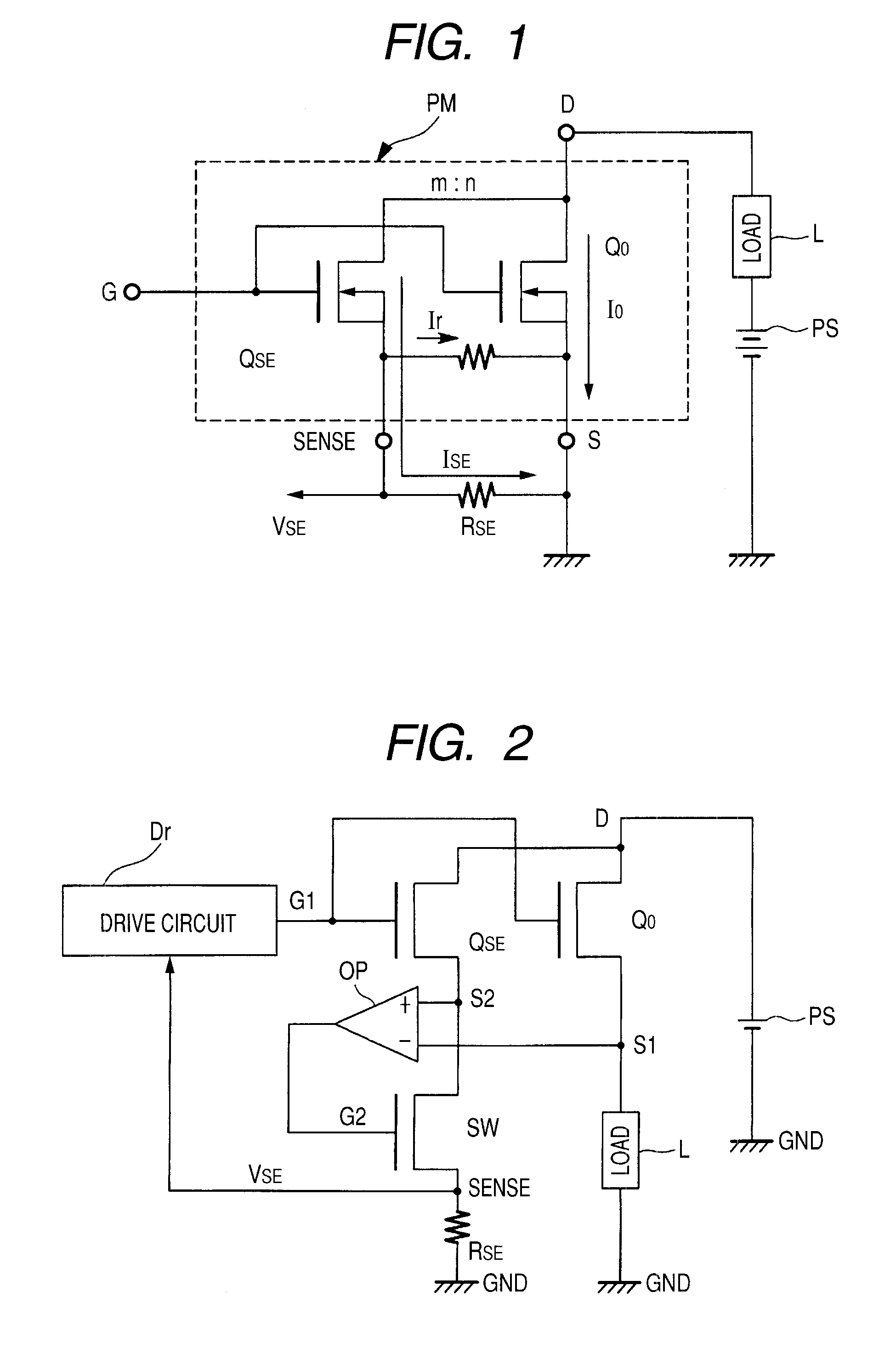Semiconductor device and manufacturing method of the same
a technology of semiconductor devices and semiconductors, applied in semiconductor devices, diodes, electrical apparatuses, etc., can solve the problems of limiting the reduction of resistance, and achieve the effect of large power
- Summary
- Abstract
- Description
- Claims
- Application Information
AI Technical Summary
Benefits of technology
Problems solved by technology
Method used
Image
Examples
first embodiment
[0076]When overcurrent of a rated value or more flows in a semiconductor device using a power MISFET, there is a fear that a load circuit (element) coupled to the power MISFET or the power MISFET itself (element) is destroyed. Therefore, the semiconductor device using the power MISFET is provided with a function for preventing the breakdown of each element due to the overcurrent. An example of a circuit for preventing the breakdown of each element due to the overcurrent will be explained.
[0077]FIG. 2 is a circuit diagram showing a circuit for driving a load using a power MISFET having a current sensing or detection circuit. In FIG. 2, a drain terminal D of a main cell (power MISFET) Q0 is coupled to a power supply PS. A load L is coupled between a source terminal S1 of the main cell Q0 and GND. The drain terminal D of the main cell Q0 is used in common with a drain terminal D of a sense cell (power MISFET) QSE. Further, a gate terminal G1 of the main cell Q0 and a gate terminal G1 o...
second embodiment
[0137]The present embodiment will explain a configuration of a power MISFET capable of enhancing a breakdown voltage (BVdss) in addition to the configuration of the first embodiment. FIG. 16 is a plan view showing part of the power MISFET according to the second embodiment. FIG. 16 shows an active cell AC corresponding to the power MISFET, a sense cell SC for current detection, and inactive cells IAC provided around a sense cell SC to separate the active cell AC and the sense cell SC from each other. This configuration is similar to the first embodiment. The active cell AC, the sense cell SC and the inactive cells IAC comprise a trench gate type power MISFET. Here, the power MISFET according to the second embodiment differs from the power MISFET according to the first embodiment in that an electric field relaxation layer 18 is provided in a peripheral area or region that surrounds the sense cell SC. The electric field relaxation layer 18 comprises a p-type semiconductor region.
[0138...
third embodiment
[0141]Although the first embodiment has explained the configuration in which the leak current developed between the sense cell SC and the active cell AC is reduced, the present embodiment will also explain an example of another configuration in which a leak current developed between a sense cell SC and an active cell AC can be reduced, and a configuration example capable of realizing a further reduction in the leak current.
[0142]FIG. 18 is a sectional view showing a structure in which a leak current developed between a sense cell SC and an active cell AC presents a problem. The sense cell SC, active cell AC and inactive cells IAC are illustrated in FIG. 18. A description will first be made of a configuration of a sense cell SC formed in its corresponding sense cell forming area. In FIG. 18, an n-type epitaxial layer 21 in which an n-type impurity such as phosphorus or arsenic has been introduced, is formed over a semiconductor substrate 20S. A channel forming region (semiconductor r...
PUM
 Login to View More
Login to View More Abstract
Description
Claims
Application Information
 Login to View More
Login to View More - R&D
- Intellectual Property
- Life Sciences
- Materials
- Tech Scout
- Unparalleled Data Quality
- Higher Quality Content
- 60% Fewer Hallucinations
Browse by: Latest US Patents, China's latest patents, Technical Efficacy Thesaurus, Application Domain, Technology Topic, Popular Technical Reports.
© 2025 PatSnap. All rights reserved.Legal|Privacy policy|Modern Slavery Act Transparency Statement|Sitemap|About US| Contact US: help@patsnap.com



